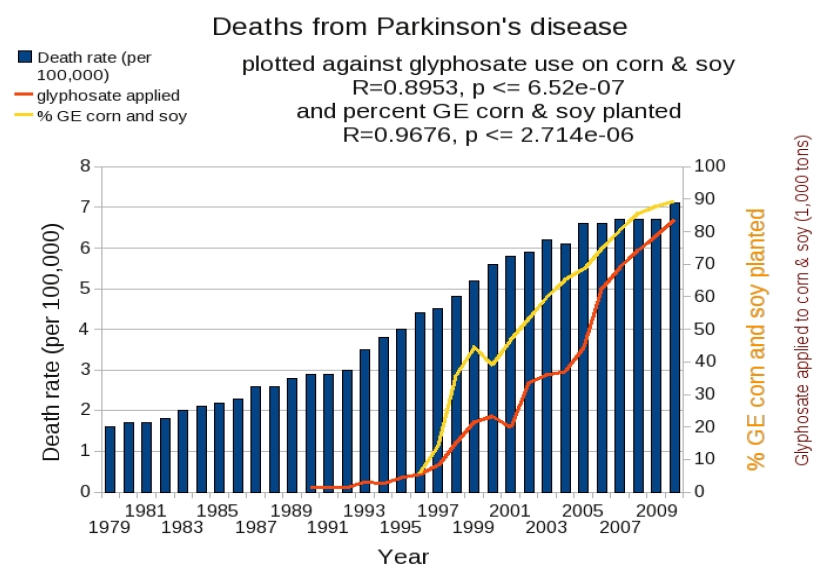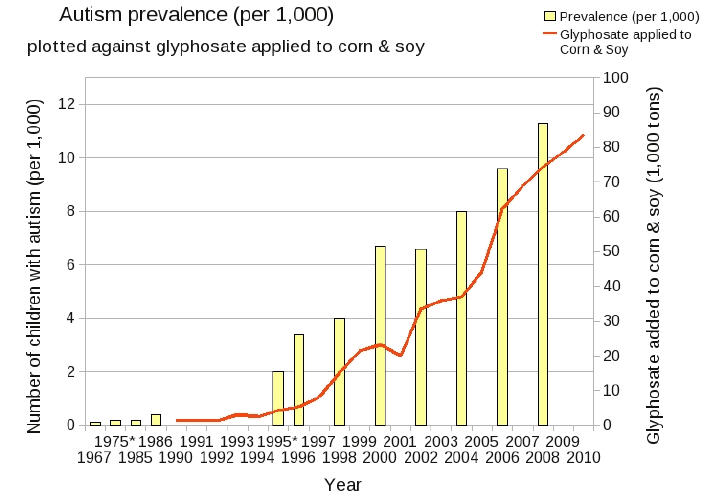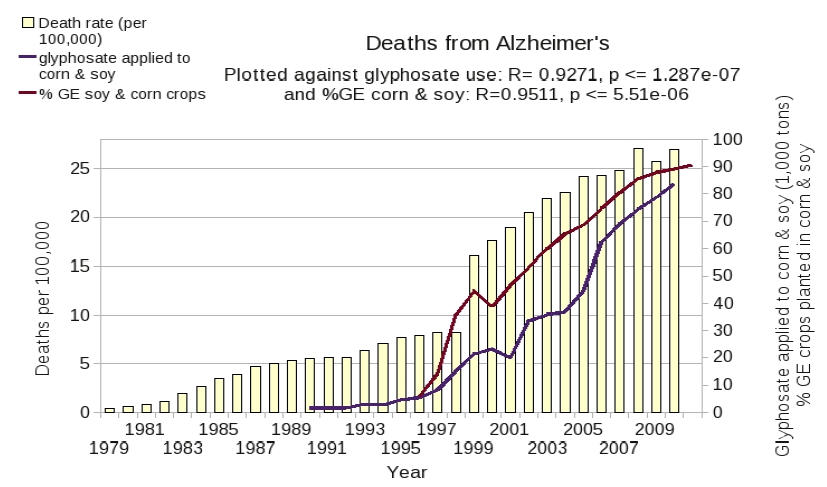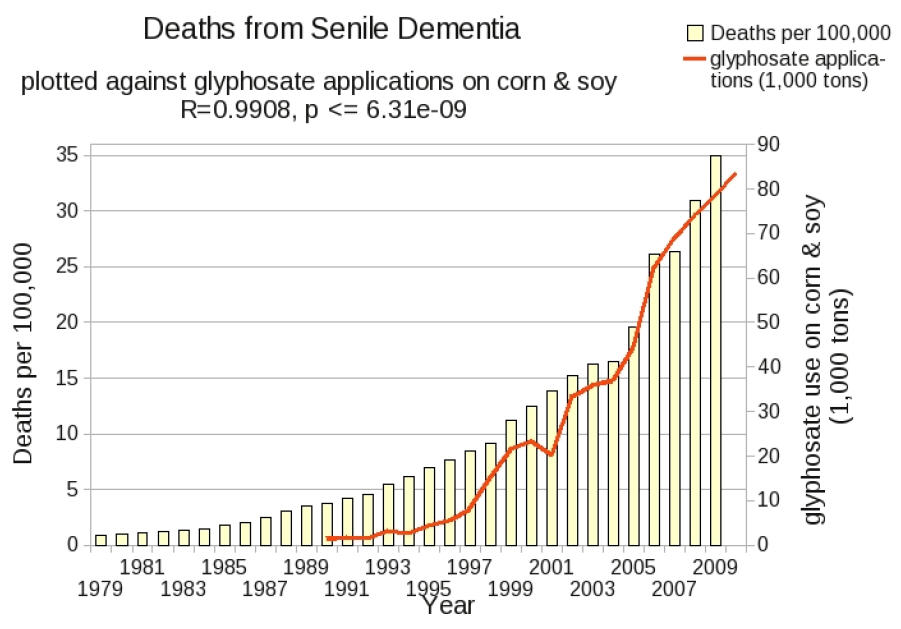
GMOs & NEUROLOGICAL DISEASE: ADHD, AUTISM, ALZHEINER'S, SCHIZOPHRENIA, BIPOLAR
N. L Swnason
Acknowledgment: Jon Abrahamson helped with data mining for this article.
The endocrine disrupting properties of glyphosate can lead to neurological disorders (learning disabilities (LD), attention deficit hyperactive disorder (ADHD), autism, dementia, Alzheimer’s, schizophrenia and bipolar disorder). Those most susceptible are children and the elderly.
Glyphosate was first marketed in 1976 and its use has exploded since the advent of glyphosateresistant, genetically engineered (GE) crops in 1995. The herbicide-resistant GE crops absorb glyphosate through direct application and from the soil and it cannot be washed off. It is in the food. Glyphosate has also been found in rivers, streams, air and rain.
The thyroid is an endocrine organ that secretes the thyroid hormone. Thyroid dysfunction has been identified with mood disorders. Depression is frequently associated with low levels of thyroid hormone (hypothyroidism), while mood elevation is often associated with high levels of thyroid hormone (hyperthyroidism). An endocrine disrupting chemical (EDC) can cause erratic behavior. Recent studies have shown links between food additives and neurotoxicity in cells and hyperactive behavior in children. Incidents have been reported of laboratory rats and farm animals exhibiting uncharacteristic aggressive and anti-social behavior on being fed a diet consisting of GMO soy or corn.
Many scientific studies have shown links between thyroid disruption and neurological diseases. “Thyroid hormones are critical for development of the fetal and neonatal brain, as well as for many other aspects of pregnancy and fetal growth. Hypothyroidism in either the mother or fetus frequently results in fetal disease; in humans, this includes a high incidence of mental retardation. … numerous studies with rats, sheep and humans have reinforced this concept…” According to de Cock et al, “Perinatal exposure to EDCs appears to be associated with the occurrence of ASD [autism spectrum disorder] as well as ADHD. Disruption of thyroid hormone function … may offer an explanation for the observed relations….” MacSweeney et al. report, “that the mothers of 104 schizophrenic patients had: (1) a significantly higher incidence of thyroid disease than a carefully matched control group; (2) significantly more abortions, still-births and greater infant mortality. The findings and possible relevance of thyroid disease to schizophrenia are discussed.” Strong correlation was shown between cancer of the thyroid and glyphosate use on corn and soy crops and that thyroid cancer affects women more than men. It seems that women are more sensitive to thyroid disruption.
The incidence and prevalence for neurological disorders have been skyrocketing. Data trends over time for neurological disorders are not readily available for two reasons: they are not as well-studied as other diseases (cancer, diabetes etc.), and the diagnostic methods keep changing. The experts argue over whether the increases are real, or a by-product of changes in diagnostics along with greater attention given to these disorders in recent times. For example, a former diagnosis of mental retardation might now result in a diagnosis of autism. Furthermore there is a large degree of overlap in symptoms. Typical manifestations of ADHD, such as distractibility or hyperactivity are also present in pediatric bipolar disorder, for example.
Children
ADHD
According to the New York Times, “an estimated 6.4 million children ages 4 through 17 had received an A.D.H.D. diagnosis at some point in their lives, a 16 percent increase since 2007 and a 41 percent rise in the past decade.” From the Center for Disease Control (CDC), “rates of ADHD diagnosis increased an average of 3% per year from 1997 to 2006 and an average of 5.5% per year from 2003 to 2007. … It is not possible to tell whether this increase represents a change in the number of children who have ADHD, or a change in the number of children who were diagnosed.” It alsomakes a great deal of difference who is doing the reporting: parents or doctors. The disorder affects boys more than girls. Whatever the numbers, there seems to be an increasing behavioral problem with our youth. Our solution is to give them more chemicals in the form of mood-altering drugs.
Bipolar
According to a 2007 report by Moreno et al., “the annual number of office-based visits with a diagnosis of bipolar disorder was estimated to increase in youth from 25 (1994-1995) to 1003 (2002-2003) per 100,000 population, whereas in adults it increased from 905 (1994-1995) to 1679 (2002-2003) per 100,000 population. … most youth bipolar disorder visits were by males (66.5%), whereas most adult bipolar disorder visits were by females (67.6%).”
Autism
The number of autistic children has exploded during the last decade, and some are calling it an epidemic. There is great controversy over what is causing this and whether all of it is real. “But many researchers now say that at least part of the rise in autism is real and caused by something in the environment. Rather than quibbling over recounts they are focusing on finding the causes.”
It was shown in previous articles that there has been a huge increase in the amount of glyphosates applied to corn and soy crops grown in the U.S. corresponding to the rise in the percentage of corn and soy planted with genetically engineered (GE) varieties. Those data represent only a portion of the total GE crops and amount of glyphosates applied. The USDA only collects data on GE crops for corn, cotton and soy. Since most of the corn (88%) and soy (94%) planted now is GE, these data give a representation of the rising trends in both GE crops and herbicide use.
The amount of glyphosate applied to U.S. corn and soy crops is plotted against the prevalence of autism in the graph below. The prevalence of autism was difficult to find and the values shown on this graph came from many sources using different methods and different age groups. A better estimate was obtained from the U.S. Department of Education, which keeps track of school age children receiving services under the Individuals with Disabilities Education Act (IDEA). A second plot is shown using data from USDE for the number of autistic children receiving services. The correlation is quite strong which may indicate that glyphosate is a contributing factor in the rise of autism
Elderly
The elderly are susceptible because they may already have a great body burden of chemical exposure over their lifetime and because some of their body processes are shutting down and hormonal disruptions can have a much greater effect on them.
According to the University of Washington Institute for Health Metrics and Evaluation, Alzheimer’s disease went from number 32 in 1990 to number nine in 2010 in the ranking of leading causes of death in the U.S. Senile Dementia and it’s care costs have also skyrocketed in the last two decades.
Prevalence and incidence data were sparse, but data on death rates were available from 1979. Graphs of the death rates for Alzheimer’s, Parkinson’s disease and Senile Dementia have been plotted against glyphosate applications to U.S. corn and soy crops. Again, the correlations are quite strong. Deaths due to Alzheimer’s have been rising since 1980, but there is a sharp spike in 1999.
Correlation does not necessarily imply causation and there are now a host of chemicals in our food and our environment. The huge increase in the amount of glyphosate applied to GE food and feed crops has significantly increased our exposure to endocrine disrupting chemicals. In a previous article, correlations were shown between glyphosate use, GMO crop increase and: thyroid cancer, liver cancer, obesity, high blood pressure, acute kidney injury, incidence and prevalence of diabetes and end stage renal disease. All of these diseases and disorders were carefully chosen based on:
1 Glyphosate is a known endocrine disruptor.
2. Endocrine disruptors can cause organ and neurological damage.
3. Roundup™ and GMOs have shown liver and kidney damage and abnormal behavior in rat studies.
4. Use of glyphosate on herbicide-resistant crops has skyrocketed since 1995.
5. Incidence, prevalence and deaths due to these diseases has also skyrocketed since 1995.
It seems improbable that the correlations in the nine graphs of glyphosates and organ disease, and the three presented here (for a total of 12), can all be coincidence. There has been a trend among the agricultural and food industries and their regulators to engage in practices that place the consumers at risk, emerging in the mid-1990s and growing. It involves not just GMOs but many other things as well and those factors may may be correlated with each other. That may make it impossible to separate out which one caused a particular effect. Much more research needs to be done. Our children are disturbed and our elders are dying horribly.

Notes:
In 2006 Irena Ermakova reported to the European Congress of Psychiatry that, “As in previous series the behavior of males from GM group was compared with the behavior of control rats. Obtained data showed a high level of anxiety and aggression in males, females and young pups from GM groups. Aggression was more expressed in females and rat pups: they attacked and bite each other and the worker.” 14th European Congress of Psychiatry, Nice, France, Sunday, March 5 2006, Poster #048.
Numerous anecdotal reports of animals on GMO diets behaving aggressively and anti-socially have been reported by farmers and veterinarians.
In 2010 Shelton et al. published a paper describing potential mechanisms linking pesticides and autism.
In 2006, Grandjean and Landrigan reported on developmental neurotoxicity of industrial chemicals. “Neurodevelopmental disorders such as autism, attention deficit disorder, mental retardation, and cerebral palsy are common, costly, and can cause lifelong disability. … Exposure to these chemicals during early fetal development can cause brain injury at doses much lower than those affecting adult brain function.”
Data sources:
Alzheimer’s & Senile Dementia death data : CDC compressed mortality files
Autism prevalence: CDC: 1975* & 1995* from NAT U R E | VO L 4 7 9 | 3 NOV E M B E R 2 0 1 1
Autism IDEA data: 1992-1998
1999-2010 http://nces.ed.gov/FastFacts/display.asp?id=64
U.S. Dept. of Education, National Center for Education Statistics (2012). Digest of Education Statistics, 2011 (NCES 2012-001), Chapter 2.
Glyphosate: USDA:NASS National Agricultural Statistics Service (NASS)
Percent GE corn & soy data: 1996-1999 data: USDA Agricultural Economic Report No. (AER-810) 67 pp, May 2002
2000-2012 data: USDA:NASS National Agricultural Statistics Service
- See more at: http://globalresearchreport.com/2013/10/08/gmos-neurological-disease-adhd-autism-alzheimers-schizophrenia-bipolar/?utm_source=feedburner&utm_medium=email&utm_campaign=Feed%3A+globalresearchreport+(Global+Research+Report)#sthash.LDJAxrfe.txnL0nU8.dpuf






